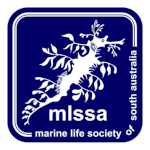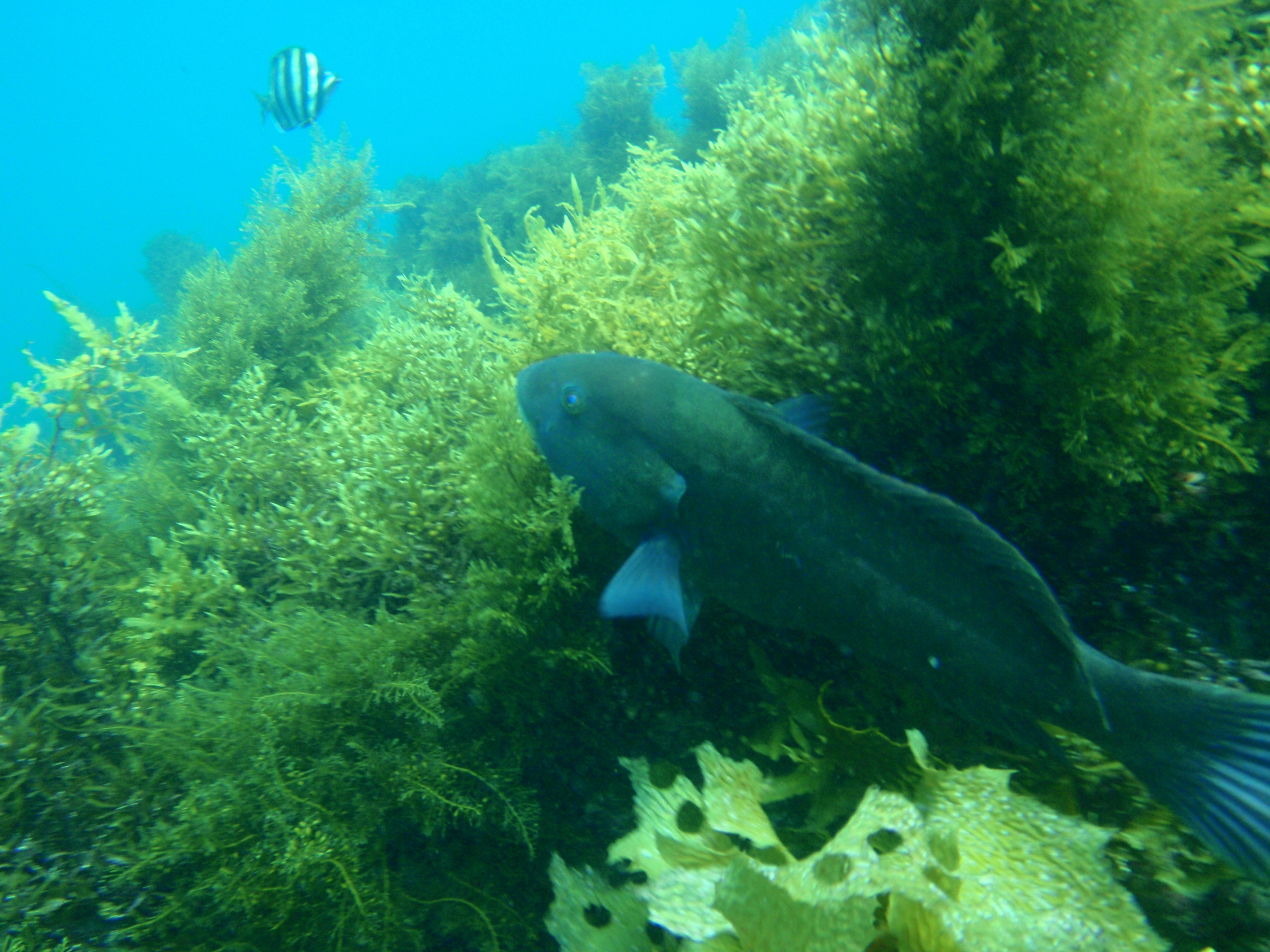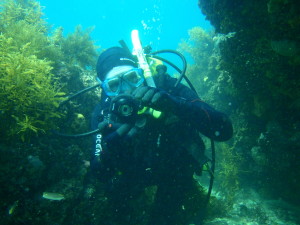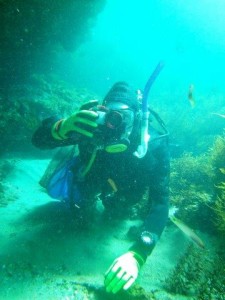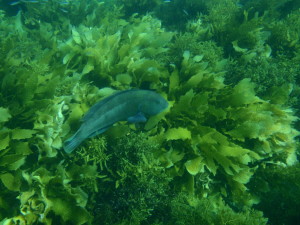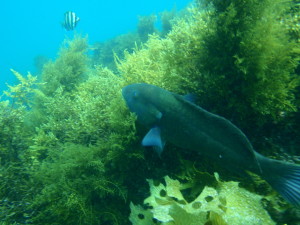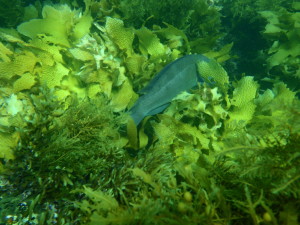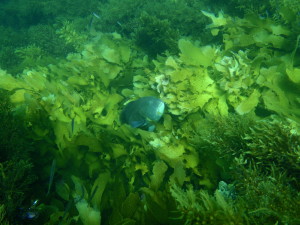When David Muirhead suggested that we dive at Carrickalinga for our Anzac Day dive (25th April), I happily agreed, since I hadn’t dived there recently, or very much at all for that matter.
It seems that no one else was able to join us that day, so it was just the two of us that met at the car park there on the seafront. We simply had to gear up in the car park and walk down a ramp onto the narrow beach and towards the water near some rocks there. We came across a shallow reef after a brief snorkel. We then swam over a sandy bottom, which soon became rocky reef once more.
We swam further out to sea, into deeper water. The reef became more pronounced, with higher rocks and lots of ledges and caves. There were quite a few high rocky bommies to be seen there.
There was a moment when we both turned towards each other and took a photo of each other.
Steve’s photo of David and David’s photo of Steve
The fish life there seemed to be quite large, with large drummer & strongies swimming around. Even the moonlighters seemed to be quite large. We both had small cameras with us and were able to photograph the numerous fish to be seen.
David and I both enjoyed exploring the many holes, ledges and small caves in the area. We saw fish such as old wives, leatherjackets, herring cale, magpie perch, trachinops, bullseyes, scaly fin, silverbellies, zebra fish, wrasses and western cleaner clingfish.
I think that we also saw examples of western cleaner clingfish cleaning large fish. I think that I disturbed one clingfish’s work when the client fish swam away. The clingfish then turned its attention to me and swam right up to my face mask as if it wanted to clean that.
David had apparently seen a wobbegong shark under a large ledge earlier in the year. He was hoping to find it there once more. He says that he found the same ledge but the shark was not there at the time.
I got quite excited when we were both joined by a large wrasse. I actually thought that it was a western blue groper. It kept swimming close by us and kept returning back to us, checking us both out regularly.
Large wrasse at Carrickalinga
(Taken by Steve Reynolds)
I also saw a small cuttlefish out there. No doubt David saw some more different fish and invertebrates. He later sent me a photo of a juvenile blue devil, for example. He says that he saw a few of them (at least three). He also seems to have at least seen some small squid, starfish and sea urchins. Looking back through my own photos, I found one of a black-spotted wrasse.
We exited back at the beach at about 12.20pm. Our total dive time was 90 minutes and we had reached a depth of 5-6m. The visibility had been ‘fair’ and the sea had been a little choppy. We had water temperatures of 20-22C.
We changed back at the car park before going to David’s nearby home to have some lunch. At some stage after the dive, David had mentioned something about a large wrasse sighting. I didn’t get the opportunity to ask him what he was referring to at all. It later concerned me that he may have been referring to my ‘blue groper’ sighting. I later sent him a message asking him about his large wrasse sighting. It seems that he had seen a large “male brown-spotted wrasse, Notolabrus parilus, which I don’t recall seeing myself. He soon sent me the following details: –
“The big wrasse at Carrickalinga was a very mature, male brown-spotted (or orange-spotted) wrasse, Notolabrus parilus. In my experience they don’t get more than a few centimetres longer than that one and also I’d say it’s the same one I saw at (the) same bit of that reef on the several dives I did there back in January (2016), with Kevin Smith on one dive and Healy and Graham (Short) on another.
I’ve some good videos of it, one clip from January and several from the dive with you most recently.
(P.S. If you are asking because of an article for (the) MLSSA (web) site you could include the above repeated sightings to emphasize wrasse territorial nature and even extend that to mention that small western blue groper wrasse episodically establish territories in the same Carrickalinga inshore higher relief reefs off both the north and south beach bays, but they don’t seem to last long probably because they are caught on line recreationally (i.e not the target species, just accidentally, but the usual problem of the fisher not realizing what it is, hence not returning it to the water) and doubtless a few are targeted by spearos, who mostly would also not be sure what they had got, but would spear them based on size alone…the several I’ve seen on both the above areas of reef, several times each but now several years ago, were quite big juveniles, with James Brook’s particular (blue groper) friend being easily 50 centimetres long and not quite as wary as it should have been in an area heavily visited by spear fishermen. But the good news is that now that we have the marine parks at each end of the bay I expect that small populations of the species will manage to establish permanent territories within the areas where spears are banned.
Depending on how much impact the still legal recreational line fishing still has in the protected areas.
The roads to the shore and marina access points for Rapid Head and Carrickalinga Head parks are going to need big educational signs about blue groper and harlequin fish or the parks will still be unable to support groper juveniles.)”
As it turned out, David & I ended up discussing our fish sightings over the phone. David had since seen a photo of my ‘blue groper’ sighting and he was starting to believe that I was correctly identifying the fish. All I had to do to satisfy him 100% was to send him more of my photographs of the fish for him to look at.
More wrasse photos
(Taken by Steve Reynolds)
His response to my photos, however, was “These images are definitely all of a mature male brown-spotted wrasse.”
He went on to say,” better % cover of Ecklonia radiata in most of your N. parilus male pics, than I recalled in our chats today, happily. (But interestingly perhaps, the fish seems to prefer using the kelp for cover, based on your series of images, and I feel I can anecdotally affirm that is the case generally with this large distinctive wrasse in our Gulf waters. Maybe same for the most common of the larger wrasses in S.A., the blue-throat wrasse, but I’ve not given that much thought. And, come to that, another mild surprise for me on that recent Carrickalinga dive with you was the COMPARATIVE scarcity of larger adult males (or even smallish adult males) of blue-throat wrasse, which I’d again guess is via human recreational predation as a major factor, since they seem to be one of, if not the most, easily hooked wrasses here in SA, and probably, like the western blue groper wrasse, the males get first go at the bait.)
